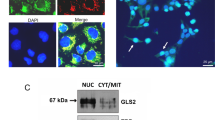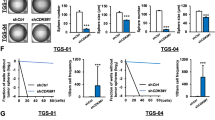Abstract
We previously demonstrated that P16Ink4a (p16) expression in p16-deficient U343 astrocytoma cells causes a G1 cell cycle arrest, profound changes in cytoskeletal proteins and alterations in expression and activity of the pRB and E2F family proteins. We examine here the effects of expressing wild type or mutant versions of the downstream targets of p16 in U343 astrocytomas. We first attempted to block proliferation of U343 cells using the dominant mutant of pRB, Δp34. Expression of this mutant in the human osteosarcoma, SAOS-2, potently blocked proliferation but did not affect the cell cycle of U343 cells. We next showed that expression of E2F-1, E2F-2, E2F-3 and E2F-4 are each able to overcome this p16-dependent cell cycle arrest but exhibit distinct biological activities. Adenoviral-mediated expression of E2F-1, E2F-2, E2F-3, or E2F-4 overcame the p16-dependent cell cycle block and induced alterations in cell morphology. E2F-5, only in conjunction with DP1, promoted cell cycle progression. For both E2F-1 and E2F-2, but not E2F-3 or E2F-5/DP1, cell cycle re-entry was associated with almost quantitative cell death. Only small numbers of dying cells were observed in E2F-4-expressing cultures. Expression of the different E2F's altered the expression of distinct sets of cell cycle regulatory proteins. E2F-1 induced endogenous E2F-4 expression and also caused an increase in pRB, p107 and cyclin E levels. Expression of E2F-4 caused a weak increase in E2F-1 levels but also strongly induced pRB, p107, p130 and cyclin E. However, E2F-1 and E2F-4 clearly regulate expression of distinct genes, demonstrated when E2F-4 caused a threefold increase in the levels of cdk2 whereas E2F-1 failed to increase in this cyclin dependent kinase. Similarly, expression of E2F-1 or E2F-2 were shown to have distinct effects on the expression of cdk2, cyclin E and pRB despite both of these closely related E2F-family members potently inducing cell death. Thus, E2F-1, E2F-2, E2F-3 and E2F-4 are able to overcome the p16-dependent proliferative block in U343 astrocytoma cells. While overcoming this cell cycle block, each of the E2F's uniquely affect the expression of a number of cell cycle regulatory proteins and have distinct abilities to promote cell death.
This is a preview of subscription content, access via your institution
Access options
Subscribe to this journal
Receive 50 print issues and online access
$259.00 per year
only $5.18 per issue
Buy this article
- Purchase on Springer Link
- Instant access to full article PDF
Prices may be subject to local taxes which are calculated during checkout
Similar content being viewed by others
Author information
Authors and Affiliations
Rights and permissions
About this article
Cite this article
Dirks, P., Rutka, J., Hubbard, S. et al. The E2F-family proteins induce distinct cell cycle regulatory factors in p16-arrested, U343 astrocytoma cells. Oncogene 17, 867–876 (1998). https://doi.org/10.1038/sj.onc.1202008
Received:
Revised:
Accepted:
Published:
Issue Date:
DOI: https://doi.org/10.1038/sj.onc.1202008
Keywords
This article is cited by
-
E2F1 mediated DDX11 transcriptional activation promotes hepatocellular carcinoma progression through PI3K/AKT/mTOR pathway
Cell Death & Disease (2020)
-
Chromatin accessibility and transcription dynamics during in vitro astrocyte differentiation of Huntington’s Disease Monkey pluripotent stem cells
Epigenetics & Chromatin (2019)
-
QM-FISH analysis of the genes involved in the G1/S checkpoint signaling pathway in triple-negative breast cancer
Tumor Biology (2014)
-
Proapoptotic role of novel gene-expression factors
Clinical and Translational Oncology (2007)
-
Regulation of epidermal apoptosis and DNA repair by E2F1 in response to ultraviolet B radiation
Oncogene (2005)



